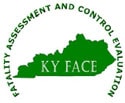Dump Truck Driver Dies After His Vehicle was Struck by A Train
Kentucky Case Report: 06KY057
Report Release Date: September 28, 2007
Summary
On a late summer morning, at approximately 6:10 AM, a 63-year-old, self-employed male dump truck driver left his home hauling a load of dry septic waste. He was hauling the septic waste to a nearby town for disposal. His home was located at the end of a dead-end street, parallel to the nearby railroad tracks. After the driver exited his driveway, he drove down the street parallel to the tracks which ran north and south. There was a train on the tracks traveling approximately 33 miles per hour. The train engineer, after clearing some trees located between the railroad tracks and the dump truck driver’s house, observed the dump truck driver approach the railroad crossing, applied the train brakes and shut down power to the engine. The train struck the dump truck on its passenger side, pushing it over onto its right side. The driver, who was not wearing a seatbelt, was ejected from the truck and pinned underneath the front right tire. The train engineer called emergency medical services who was dispatched immediately. Emergency medical services arrived and transported the driver to a nearby trauma hospital where he arrived at approximately 7:07 AM. He died 5 ½ hours later due to multiple blunt force injuries sustained in the crash.
To prevent future occurrences of similar incidents, the following recommendations have been made:
- Dump truck drivers should obey all traffic guidelines pertaining to railroad track crossings.
- If a commercial vehicle stalls on a railroad grade crossing, the driver
should immediately exit the vehicle and contact emergency services. - Commercial drivers should always wear safety belts while operating a motor vehicle.
- The state of Kentucky should adopt a vegetation clearance code/regulation pertaining to sight of clearance along railroad tracks and crossings.
Background
The Kentucky Fatality Assessment and Control Evaluation Program was notified via newspaper of an occupational death involving a dump truck driver whose vehicle was struck by a locomotive. A field evaluator and a representative from the National Institute for Occupational Safety and Health Administration conducted a site visit. The police were interviewed.
The decedent owned and operated a family-owned septic and environmental services business that began in 1943. Services provided by the company were septic tank and systems cleaning and repairing, water treatment and conditioning, pumping contracting, waste water treatment, and grease trap cleaning.
Investigation
One late summer morning, at approximately 6:10 AM, a 63-year-old, self-employed male dump truck driver left his home hauling a load of dry septic waste. His house was located at the end of a cul-de-sac parallel to railroad tracks. The train tracks ran north and south. He was hauling the waste to a nearby town for disposal. After the driver exited his driveway, he drove in a northerly direction down a street parallel to the railroad tracks. At the end of the street he should have stopped at a stop sign, turned right, driven approximately 50 feet, driven over the railroad tracks and then after another 100 feet, stopped at another stop sign, then entered a four-lane highway on the other side. The railroad tracks were identified by crossbucks on both sides of the approaching roadway. There were no signal lights, automatic gate controls, or pavement markings at the intersection. The road surface at the railroad-grade crossing was composed of the railroad tracks and wooden railroad ties. Fourteen trains and approximately 50 vehicles cross through this intersection daily.
A freight train comprised of one locomotive and 55 cars, was traveling north at approximately 33 mph through a stand of trees (Photo 1). The train engineer observed the dump truck traveling down the street ahead of the train. He then saw the dump truck stopped on the tracks in front of the train. The engineer attempted to stop the train but struck the dump truck on the passenger side, pushing it around and over onto its right side. Because the train was traveling through a residential area, the train engineer had sounded the train whistle continuously, and the lights on the train were illuminated. The speed limit for trains was 35 miles per hour.
Upon impact, the driver, who was not wearing a seatbelt, was ejected from the truck and found pinned underneath the right front tire of the dump truck. After striking the dump truck (Photo 2), the engineer contacted emergency medical services. Emergency medical services arrived, removed the driver from underneath the truck and transported him to a nearby trauma hospital where he arrived at 7:07 AM. He died 5 ½ hours later due to multiple blunt force injuries sustained in the crash.
Cause of Death
The coroner’s report states the cause of death was due to multiple blunt force injuries sustained in a motor vehicle versus train collision. The death certificate also stated the decedent was diabetic.
Recommendations and Discussion
Recommendation No. 1: Dump truck drivers should be obey all traffic guidelines and regulations pertaining to railroad track crossings.
There are 4,838 private and public railroad crossings in Kentucky. It is estimated that there are only 50 vehicles which travel through this particular railroad crossing every day. Commercial drivers should be educated, and practice proper driving rules on how to approach, cross over, and clear railroad tracks safely. Drivers of commercial vehicles are required to stop the commercial motor vehicle within 50 feet of, and not closer than 15 feet to the tracks (Federal Motor Carrier Safety Administration 49 CFR 392, Subpart B – Driving of Motor Vehicles Statute 392.10 Railroad grade crossings; stopping required). The driver must then listen and look in each direction along the tracks for an approaching train. We do not know if the driver of the dump truck stopped, looked, and listened for the possibility of an approaching train or if he was inured to the sounds of the locomotives. To assist commercial drivers in similar circumstances, the following agencies have developed a board visor with safety tips for drivers to follow when approaching train tracks: U.S. Department of Transportation, Federal Motor Carrier Safety Administration, Federal Railroad Administration, and Federal Highway Administration. The board should be placed on the window visors of commercial vehicles and referred to when needed. There are seven steps drivers should perform while crossing railroad tracks as stated on the board: 1) when approaching a railroad crossing, drivers should slow down and turn on 4- way flashers to warn other drivers to do the same; 2) drivers should turn off fans, and radios; roll down windows, and locate their cell phone in case of emergency. The driver should then stop the vehicle no closer than 15 feet, but no further than 50 feet from closest track; 3) drivers should then lean forward and look around mirrors and A-pillars, and listen closely for an approaching train; 4) drivers should not cross over the tracks unless the vehicle can completely clear the tracks. The driver should allow for the train to extend 3 feet over the tracks on each side; 5) before crossing, the driver should check both directions again to ensure the tracks are clear and safe to cross; 6) once the driver determines it is safe to drive across the tracks, he/she should drive across the tracks in a gear that permits the commercial motor vehicle to complete the crossing without a change of gears; 7) if a driver begins to cross the tracks and the lights begin to flash or the gates begin to come down, the driver should continue to drive across and clear the tracks. Copies of the board visor can be downloadedpdf iconexternal icon from: http://www.fmcsa.dot.gov/sites/fmcsa.dot.gov/files/docs/7_Steps_for_Highway-Rail_Grade_Crossing_Safety.pdf. (Link Updated 4/8/2015)
Recommendation No. 2: If a commercial vehicle stalls on a railroad grade crossing, the driver should immediately exit the vehicle and contact emergency services.
On the other side of the above mentioned visor board, four rules are stated in the event a vehicle becomes disabled while on railroad tracks: “1) Get out immediately. Evacuate the vehicle.; 2) Move away. Walk toward the oncoming train, and away from the tracks at a 45-degree angle. (If the vehicle is hit, debris will spread out from the tracks in the same direction the train is moving.); 3) Locate the emergency phone number. When the driver/occupants are safely away from the tracks, find the railroad’s emergency phone number and the DOT crossing identification number posted near the crossing.; 4) Call for help. Call the railroad’s emergency phone number, the local police, or 911. Tell them a vehicle is on the tracks. Provide the location, crossing number, and the name of the road or highway that crosses the tracks.” Emergency phone numbers for railway companies are also listed on the visor. A copy of this visor board is located at the back of this report.
Recommendation No. 3: Commercial drivers should always wear safety belts while operating a commercial motor vehicle.
According to Kentucky law, Kentucky State Statute 189.125(6), all drivers, including commercial, are required to wear seat belts while operating a motor vehicle. Federal law 49 CFR 392.16 also states “the commercial motor vehicle which has a seat belt assembly installed at the driver’s seat shall not be driven unless the driver has properly restrained himself/herself with the seat belt assembly”. The purpose of the seat belt is to keep the driver restrained behind the wheel of the vehicle in case of a crash, preventing the driver from being thrown from the vehicle, being tossed around inside the vehicle, and to assist the driver maintaining control of the vehicle. In this case, the driver of the dump truck was thrown from the vehicle and the truck landed on top of him.
Recommendation No. 4: The state of Kentucky should adopt a vegetation clearance code/regulation pertaining to sight distance along railroad tracks and crossings.
According to the Kentucky Transportation Cabinet, land ownership along railroad right-of-ways in Kentucky varies from private citizen, local municipality, railroad, state, or federal ownership. Currently, there are no laws regulating responsibility of those entities in keeping vegetation such as trees, shrubs, grass, or other objects out of the right-of-ways and sight distance along railroad tracks cleared so as to not obstruct the view of motorists approaching/crossing the railroad tracks. Kentucky should adopt a regulation to require sight distances at railroad crossings be kept clear of such obstructions. Sight distances should be long enough for a driver to determine if there is enough time to safely cross and clear the tracks when a train is approaching the intersection. The U.S. Department of Transportation, Federal Highway Administration, Highway/Rail Grade Crossing Technical Working Group provides the following diagram (Figure 1) to help define appropriate sight distances at railroad crossings. A table of required sight distances by the speed of train and vehicle type also follows.
References
- Federal Motor Carrier Safety Administration 49 CFR 392, Subpart B – Driving of Motor Vehicles Statute 392.10
- Kentucky State Statute 189.125(6)
- Code of Federal Regulations, 49 CFR 392.16
- Operation Life Saverexternal icon, http://oli.org/ (Link Updated 11/15/2011)
- FMCSA-ESO-06-0014pdf iconexternal icon http://www.fmcsa.dot.gov/sites/fmcsa.dot.gov/files/docs/7_Steps_for_Highway-Rail_Grade_Crossing_Safety.pdf. (Link Updated 4/8/2015)
- Federal Motor Carrier Safety Administration website: http://www.fmcsa.dot.gov/about/outreach/railcrossing/index.htm (Link no longer available)
- U.S. Department of Transportationexternal icon, http://dot.gov
- Federal Railroad Administrationexternal icon, http://www.fra.dot.gov/Page/P0001 (Link updated 3/27/2013)
- Federal Railroad Administration, Office of Safety Analysisexternal icon, http://safetydata.fra.dot.gov/officeofsafety/default.aspx (Link Updated 11/15/2011)
- Federal Highway Administrationexternal icon, http://www.fhwa.dot.gov
- U.S. Department of Transportation, Federal Highway Administration, “Railroad-Highway Grade Crossing Handbookpdf iconexternal icon” , Revised Second Edition 2007, http://www.ite.org/bookstore/gradecrossing/lo_res_RR_BOOK.pdf
- U.S. Department of Transportation, Federal Highway Administration, Highway/Rail Grade Crossing Technical Working Group, November 2002external icon, http://www.fmcsa.dot.gov/rules-regulations/administration/fmcsr/fmcsrruletext.aspx?reg=392.22 (Link updated 11/15/2011)
- Kentucky Transportation Cabinet- Division of Right-of-Ways and Utilities
Acknowledgements
- Local police officer
- Representative of the National Institute of Occupational Safety and Health
- Kentucky Justice Cabinet
- Kentucky Department of Transportation, Railroad Right-of-Ways Division
Figures and Photographs
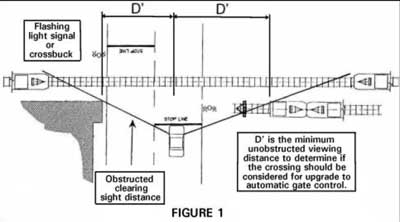
|
|
Figure 1. Diagram of Sight Distancesexternal icon
http://safety.fhwa.dot.gov/index.cfm (Link updated 8/5/2009) |
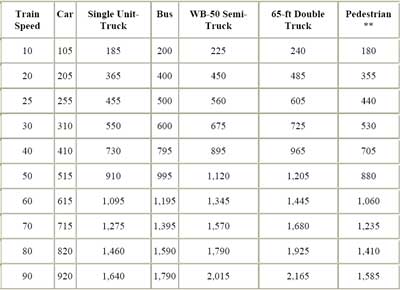 |
|
TABLE 2 CLEARING SIGHT DISTANCE (in feet)external icon * |
More information on vegetation clearance regulations, and appropriate sight distances can be obtained through the following web sites: http://www.fra.dot.gov/downloads/safety/cross_chp12.pdf (Link no longer available 3/27/2013); http://safety.fhwa.dot.gov/index.cfmexternal icon (Link updated 8/5/2009); http://www.ite.org/bookstore/gradecrossing/lo_res_RR_BOOK.pdfpdf iconexternal icon. Guidance for the regulation and required sight distances can be obtained from the Kentucky Transportation Cabinet- Division of Right-of-Ways and Utilities, U.S. Department of Transportation, and Federal Highway Administration.
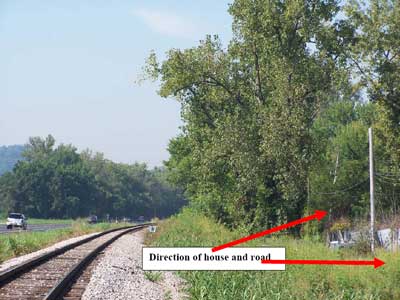 |
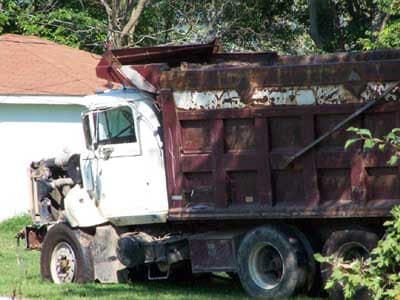 |
|
Photo 2: Photograph of truck struck by train. |
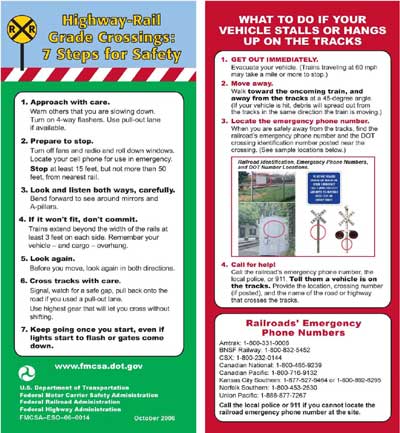 |
|
Visor board developed for commercial drivers. |
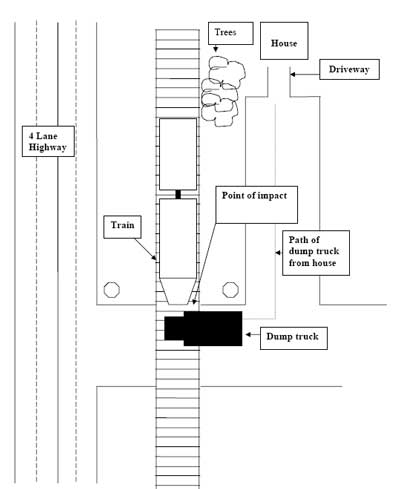 |
|
Schematic of incident. Not to scale.
|
Kentucky FACE Program
The Kentucky Fatality Assessment & Control Evaluation Program (FACE) is funded by a grant from the Centers for Disease Control and the National Institute of Safety and Health. The purpose of FACE is to aid in the research and prevention of occupational fatalities by evaluating events leading to, during, and after a work related fatality. Recommendations are made to help employers and employees to have a safer work environment. For more information about FACE and KIPRCexternal icon, please visit our website at: www.mc.uky.edu/kiprc/. (Link updated 3/27/2013)
To contact Kentucky State FACE program personnel regarding State-based FACE reports, please use information listed on the Contact Sheet on the NIOSH FACE web site. Please contact In-house FACE program personnel regarding In-house FACE reports and to gain assistance when State-FACE program personnel cannot be reached.

